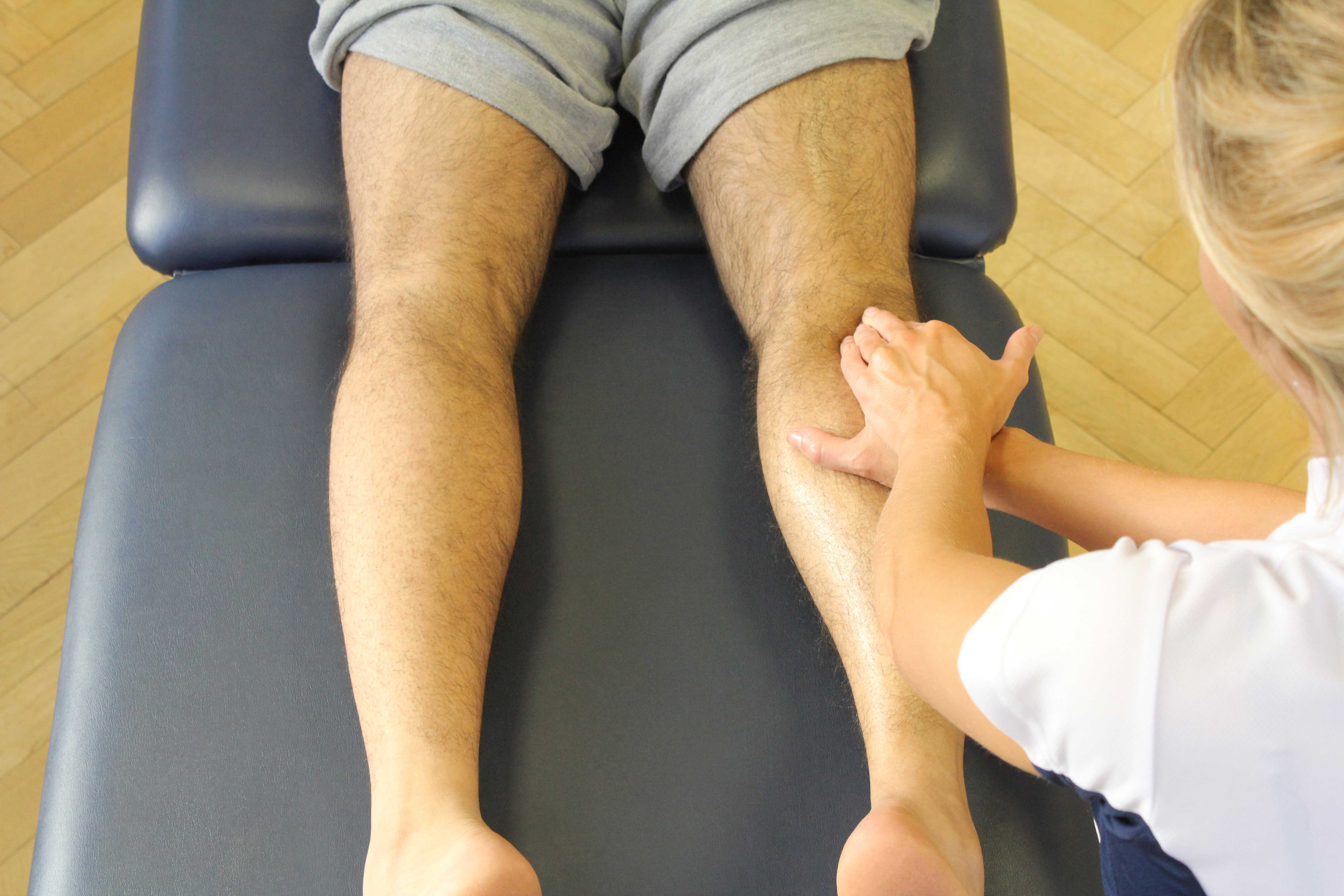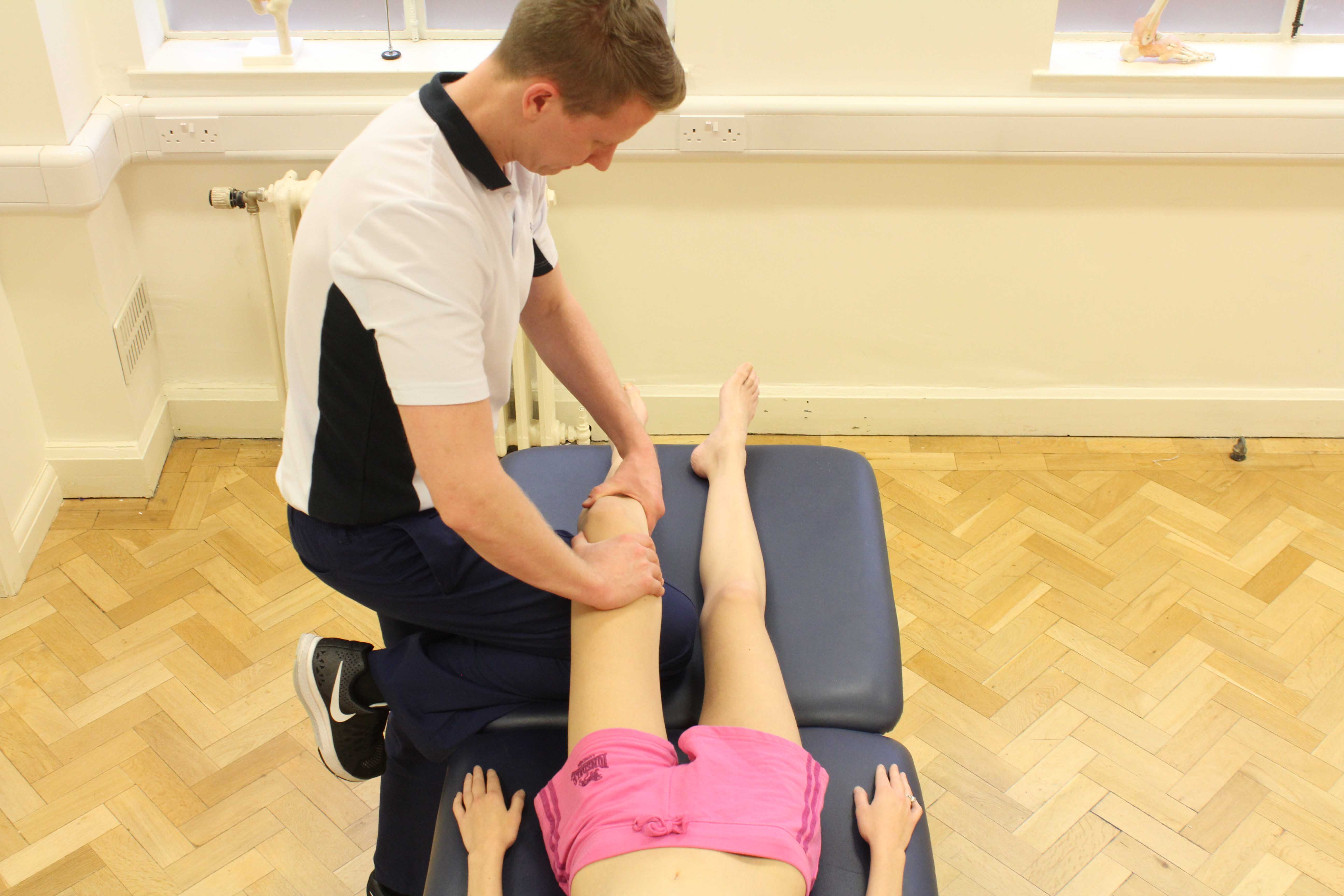- Popliteus muscle and tendon
- Popliteofibular ligament
- Biceps femoris muscle and tendon
- Lateral collateral ligament
- Fabellofibular ligament
- Arcuate ligament complex
- Posterolateral joint capsule
 Above: Therapist performing soft tissue massage on the tissues aound the knee
Above: Therapist performing soft tissue massage on the tissues aound the kneeWhat causes a posterior corner knee injury?
A posterior corner knee injury can quite commonly be caused by a sporting incident. For example, an athlete who receives an oncoming impact to the inside of a straightened knee may sustain this type of injury. Also, high impact road traffic accidents may cause a posterior corner knee injury. A posterior corner knee injury can be categorised into three groups which are:
- Grade I – no major damage or laxity
- Grade ll – minimal damage and laxity to the structures
- Grade lll – complete disruption of the structures with major disability
What symptoms caused by a posterior corner knee injury can physiotherapy help with?
Symptoms arising from a posterior corner knee injury that physiotherapy can help with include:
- Pain at the back of the knee
- Swelling
- Decreased strength
- Decreased range of movement
- Decreased function
 Above: Therapist performing knee assessment
Above: Therapist performing knee assessmentHow is a posterior corner knee injury diagnosed?
A detailed subjective and objective assessment will be carried out by a physiotherapist in order to diagnose a posterior corner knee injury. Special tests will be carried out in order to determine what structures are involved. The tests are known as:
- Lachman& Posterior drawer tests
- Posterolateral Drawer Test
- Varus stress test
- Dial Test
- Reverse Pivot Shift Test
- External Rotation Recurvatum Test
Medical Treatment
Treatment of a posterior corner knee injury depends on the grade of injury. Normally, grade l and ll injuries can be treated conservatively whereas a grade lll injury will require surgery. Physiotherapy treatment is required for all grades of posterior corner knee injuries in order to restore the knee as best as possible.
There are two different types of surgery available depending on when you sustained your posterior corner knee injury. They are:
Acute injuries - less than three weeks old and can normally be repaired. Liagaments and tendons are sewn back together or are reattached back to the bone.
Chronic injuries - more than three weeks old and require reconstruction. New ligaments and tendons are created using other structures which may include the popliteofibular ligament, the popliteustendonand the lateral collateral ligament.
For six to eight weeks following both types of surgery, partial non weight bearing is instructedand a protective hinged knee brace may be worn to allow the knee to heal. However, physiotherapy treatment can begin straight away with the main focus being on range of motion exercises and strengthening your quadriceps muscles.
Benefits of physiotherapy for a posterior corner knee injury
Physiotherapy treatment following a posterior corner knee injury can help you in many ways including:
- Decreasing pain levels
- Decreasing swelling
- Increasing range of motion
- Increasing strength
- Gait re-education
- Increasingbalance
- Returning you to function
- Returning you to pre injury activities
What would physiotherapy treatment for a posterior corner knee injury involve?
Physiotherapy treatment for a posterior corner knee injury depends on the severity of each individual injury. Following surgery, your surgeon will have a rehabilitation protocol for your physiotherapist to be guided by and will generally include:
- Walking aid education
- Range of movement exercises
- Quadriceps strengthening exercises
- Soft tissue massage
- Gait re-education
- Balance practice
- Gradual return to function
How do I arrange a physiotherapy assessment for a posterior corner knee injury?
If you or someone you know has sustained a posterior corner knee injury then you can either email us at office@liverpoolphysio.co.uk or call us on 0330 088 7800 to arrange an appointment with one of our specialist musculoskeletal physiotherapists.
Summary
If a posterior corner knee injury is left undiagnosed and untreated then serious consequences can develop.Injuries to the posterior corner of the knee often occur in combination with other ligamentous injuries to the knee. As with any injury, an in-depth understanding of the anatomy and functional interactions of the posterior corner of the knee is critical to diagnosing and treating injuries here. Here at Liverpool Physio our specialist physiotherapists seek for every individual to reach their potential. To book an appointment at Liverpool Physio then you can email us at office@.............. Or call us on…………………..

 0330 088 7800
0330 088 7800


































